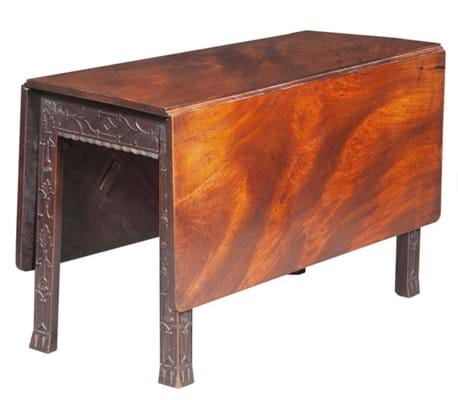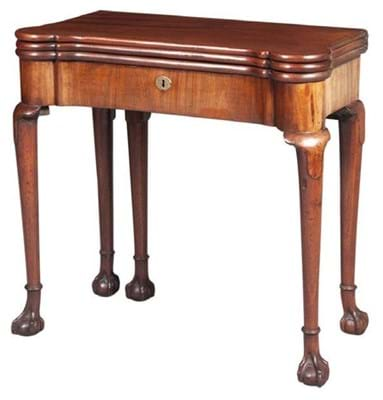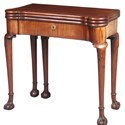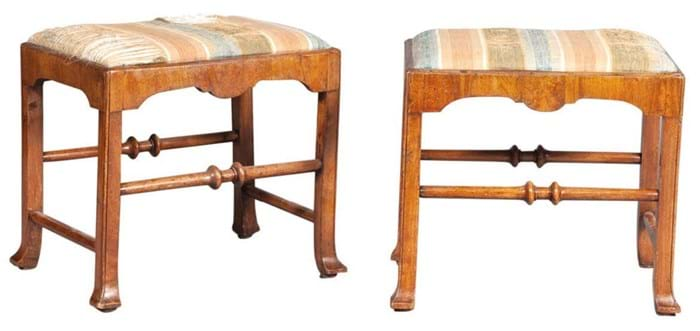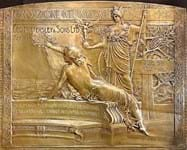Opportunities now abound to buy traditional European art and antiques Stateside.
Doyle (26% buyer’s premium), a regular choice for many vendors at a time when the top New York salerooms can be lukewarm on English country house furnishings, conducted a typical sale on August 12.
The 272-lot collection of an Upper East Side apartment had been formed primarily in the 1970s, 80s and 90s via visits to events such as Grosvenor House Art & Antiques Fair and the Winter Antiques Show. At the time, Americans couldn’t get enough of ‘proper’ art and antiques.
Today, in a very different collecting zeitgeist, many lots reappeared for sale with guides set at the bargain basement level.
Consider a pair of Queen Anne walnut stools with shaped aprons and squared splayed feet, c.1710, that came with a provenance to the collection of Benjamin Sonnenberg (1901-78), the famed public relations consultant to the stars who entertained in the lavish style from his house at Gramercy Park.
These stools, with replacement drop-in seats and one replaced stretcher, had formed part of the huge Sonnenberg sale held over five days at Sotheby’s Parke Bernet in 1979 and were later bought by the late vendor from erstwhile leading New York dealership Vernay & Jussel. The pair was offered here at just $2500-3500 but did do rather better, selling for $16,000 (£12,300).
Collectors, decorators and dealers on both sides of the Atlantic drove prices for the English furniture to respectability.
Also ex-Vernay & Jussel was a George II padouk triangular drop-leaf table with a rotating hexagonal top and lappet-carved legs ending in pad feet (above top). Now badly unfaded to one side, it sold at $4250 (£3375), the same price achieved by a George II mahogany drop-leaf card table, c.1755, (also above top) with blind fret foliate carving and guttae feet not unlike those pictured in Mayhew and Ince’s Universal System of Household Furniture (1762). The top and leaves now bowed, it had been bought from Asprey at Grosvenor House in 1977.
In good condition, a George II mahogany triple-flap table, c.1740, in the manner of the William Hallett workshop sold for $7000 (£5400).
The design allows the table to be used for tea (with a polished service), for writing (with inkwell and candle stands) and for gaming (with a baize-lined playing surface, money wells and an inlaid boards for chess and backgammon). The turned collars above the claw-and-ball feet is a feature associated with Hallett and shared by a number of fully attributed works including a suite of side chairs used by Arthur Ingram, 6th Viscount Irwin at Temple Newsam house in Leeds. The original invoice dated 1735 still survives.
Spoilum storytime
Georgian furniture was complemented by English silver, porcelain, textiles and China trade works of art.
Sold for $9500 (£7300) was a painting titled A Shipwrecked Sailor Boy Telling his Story at a Cottage Door by Spoilum (fl.1774-1810), the Chinese artist active in the Canton export trade from 1785-1810. His stock in trade were $10 portraits of Chinese and Western merchants and sea captains in the Western style (he painted in oil on canvas rather than in ink on paper or silk) but he also produced these genre scenes based on European prints.

Chinese export painting titled 'A Shipwrecked Sailor Boy Telling his Story at a Cottage Door' by Spoilum – $9500 (£7300) at Doyle.
This 20in x 2ft (51 x 61cm) scene, one that might have appealed to a seafarer, is taken from an engraving by Thomas Gaugain (1756-1812) after a painting by William Redmore Bigg published in London in 1792. It is pictured in The Decorative Arts of the China Trade (1991) where author Carl Crossman concludes it “would have certainly seem to have come from the hand of Spoilum”.
The vendor had bought it from London dealer Martyn Gregory at the Winter Antique Show, New York, in 1995. Doubtless it had cost rather more than the estimate of $1000-2000 it received here.
Also acquired from Martyn Gregory were a series of sketches of animals by the English painter George Chinnery (1774-1852). He spent most of his life in Asia, especially India and southern China. These studies, mainly of domesticated livestock, were probably made sometime in the second quarter of the 19th century when Chinnery was based in Macau.
Very much the favourite was a fully worked ink and pencil study of two Asian cows measuring 7 x 3in (8 x 18cm). Inscribed twice with the artist’s shorthand, it formed part of the exhibition From the Pearl River: Historical Pictures by Chinese and Western Artists 1750-1950 held by the Martyn Gregory gallery in 2006-07. Estimated at $300-500, it sold for $5000 (£3850).

Chamberlain’s Worcester orange ground three-piece garniture – $3750 (£2885) at Doyle.
With a provenance to Albert Amor, a Chamberlain’s Worcester orange ground three-piece garniture decorated with mythological subjects in the manner of Thomas Baxter brought $3750 (£2885). Comprising an 8½in (21cm) vase painted with Cupid and Cephisa, and a pair of 6½in (17cm) vases, one painted with Orpheus and Euridice, the other with nymph and satyr, these were in good condition, with no apparent restoration.
Some early English needleworks bought from Cora Ginsburg, New York, sold short of expectations.
Measuring close to 18ft (5.49m), a William and Mary crewelwork bed valence, c.1690, worked with a continuous vine with large green leaves was guided at $6000-8000 but hammered at $3000 (£2300).
With all lots ‘there to be sold’ in this way, the sale was a white-glove affair, totalling $540,635 (including premium), around double the pre-sale estimate.


